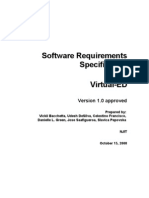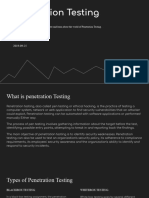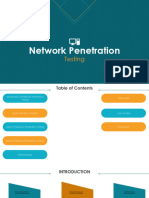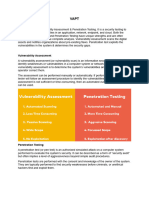Types of Penetration Testing
Types of Penetration Testing
Uploaded by
tiyaje5850Copyright:
Available Formats
Types of Penetration Testing
Types of Penetration Testing
Uploaded by
tiyaje5850Original Title
Copyright
Available Formats
Share this document
Did you find this document useful?
Is this content inappropriate?
Copyright:
Available Formats
Types of Penetration Testing
Types of Penetration Testing
Uploaded by
tiyaje5850Copyright:
Available Formats
2.
Overview of Penetration Testing
Penetration testing (pen testing) is a method used to evaluate the security of an information system by
simulating an attack from malicious outsiders (hackers) and internal threats. The primary goal of pen
testing is to identify vulnerabilities that could be exploited by attackers and provide insights for
enhancing the security posture of the organization.
Types of Penetration Testing
Black Box Testing
simulates an external attack without any prior knowledge of the internal workings of the target system.
The tester operates like an outsider, relying solely on publicly available information and tools to gather
intelligence. This type of testing provides a realistic simulation of how an external attacker might
approach the system, highlighting vulnerabilities that could be exploited without insider knowledge. It
focuses on identifying flaws in external defenses, such as firewalls, web servers, and exposed
services.
White Box Testing
offers a comprehensive evaluation of a system's security by providing the tester with full knowledge of
the system's architecture, source code, and configurations. This approach allows for a thorough
examination of the internal structure and logic, identifying vulnerabilities that may not be visible from
the outside. White box testing is useful for uncovering complex security issues, such as logical errors,
insecure coding practices, and misconfigurations that could lead to data breaches or system
compromises.
Gray Box Testing
strikes a balance between black box and white box testing by giving the tester partial knowledge of the
system. This can include limited information about the architecture, certain internal functions, or
specific components. Gray box testing aims to identify vulnerabilities that might be exploited by
insiders or attackers with some level of access or knowledge about the system. It provides a more
realistic simulation of how an attacker with some insider information might approach the system,
combining both external and internal threat perspectives.
Phases of Penetration Testing
1. Planning and Reconnaissance:
Define scope, objectives, and rules of engagement.
Identify target systems, networks, and applications.
Gather intelligence using passive and active reconnaissance techniques.
Utilize tools like WHOIS, Nslookup, and OSINT (Open-Source Intelligence).
2. Scanning:
Conduct network scanning to identify live hosts and open ports.
Perform vulnerability scanning to detect potential weaknesses.
Use tools like Nmap, Nessus, and OpenVAS for detailed analysis.
2. Overview of Penetration Testing 1
Map the network to understand the topology and identify key assets.
3. Gaining Access:
Exploit identified vulnerabilities to gain unauthorized access.
Use social engineering techniques to bypass security controls.
Deploy payloads to establish a foothold in the target system.
Utilize tools like Metasploit, SQLmap, and Hydra.
4. Maintaining Access:
Ensure persistent access by installing backdoors or rootkits.
Escalate privileges to gain higher levels of access and control.
Use techniques like lateral movement to explore the network further.
Monitor for detection and take measures to remain stealthy.
5. Analysis and Reporting:
Analyze collected data and document findings in detail.
Provide a comprehensive report with identified vulnerabilities, exploitation methods, and impact
assessments.
Offer remediation recommendations to address the discovered issues.
Present findings to stakeholders and assist with implementing fixes.
Example Tools for Penetration Testing
Nmap:
Uses: Network scanning, host discovery, service detection, OS fingerprinting, and security
auditing.
Alternatives: Zenmap (Nmap's GUI), Masscan (fast network scanner), RustScan, AngryIP Scanner.
Metasploit:
Uses: Exploitation framework for developing and executing exploit code, vulnerability testing, and
payload delivery.
Alternatives: Canvas (commercial exploitation tool), Core Impact (enterprise-grade penetration
testing tool).
Nessus:
Uses: Vulnerability scanning, compliance checking, and security auditing for networks and
applications.
Alternatives: OpenVAS (open-source vulnerability scanner), QualysGuard (cloud-based
vulnerability management).
Burp Suite:
Uses: Web application security testing, including crawling, scanning, and attacking web
applications.
Alternatives: OWASP ZAP (open-source web application security scanner), Acunetix (commercial
web vulnerability scanner).
2. Overview of Penetration Testing 2
Wireshark:
Uses: Network protocol analysis, troubleshooting, and capturing network traffic for in-depth
analysis.
Alternatives: tcpdump (command-line packet analyzer), TShark (Wireshark's command-line
counterpart).
Hydra:
Uses: Password cracking, brute force attacks against various protocols (e.g., HTTP, FTP, SSH).
Alternatives: John the Ripper (password cracking tool), Medusa (parallelized login brute-forcer).
Benefits of Penetration Testing
Identify vulnerabilities: Finds weak spots before attackers do.
Compliance: Meets regulatory requirements (e.g., PCI-DSS).
Risk Management: Helps in prioritizing and addressing risks.
Enhanced Security Posture: Improves overall security by addressing identified issues.
Challenges in Penetration Testing
Scope Definition: Defining a clear and comprehensive scope is crucial.
False Positives: Differentiating between real vulnerabilities and false positives.
Resource Intensive: Requires skilled professionals and significant time investment.
Continuous Process: Regular testing is necessary to keep up with emerging threats.
Conclusion
Penetration testing is a critical component of a robust cybersecurity strategy. By simulating real-world
attacks, organizations can proactively identify and mitigate vulnerabilities, ensuring their systems and
data are secure from potential threats. Using a combination of tools and methodologies tailored to the
specific needs of the organization can maximize the effectiveness of penetration testing efforts.
Helping Material
Different Types of Penetration Testing Methods Explained
If you are thinking about performing penetration testing in your organization, you
might be interested in learning about what are the different types of penetration
testing methods available. With that knowledge, you’ll be better equipped to define
https://www.youtube.com/watch?v=vcL28zmp9y8
Vulnerability vs Threat vs Risk | What is Vulnerability? | What is Threat? | What is Risk?
what is threat, what is threat in hindi, what is risk in hindi, what is risk, what is vulnerability, what
is vulnerability in hindi, risk vs threat, threat vs risk, vulnerability vs threat vs risk, threat vs
vulnerability vs risk, risk vs threat vs vulnerability, threat vs risk vs vulnerability, risk vs
https://www.youtube.com/watch?v=ozVHt05Ez_Q
2. Overview of Penetration Testing 3
Phases/Steps of Penetration Testing
Hi there! New to Ethical Hacking? If so, here's what you need to know -- I like share
information a LOT, so I use this channel to share ethical hacking related education.
In this video i have talked about :-
https://www.youtube.com/watch?v=pTdOavLTYQQ
2. Overview of Penetration Testing 4
You might also like
- Introduction To AmiBroker Second EditionDocument202 pagesIntroduction To AmiBroker Second EditionYakridu Anna100% (3)
- SM Sharp Mx3100nDocument467 pagesSM Sharp Mx3100njuanis100% (2)
- Perspectives Upper Intermediate Unit 2Document14 pagesPerspectives Upper Intermediate Unit 2Mariia BarnaNo ratings yet
- Vulnerability Assessment and Penetration TestingDocument6 pagesVulnerability Assessment and Penetration Testingseventhsensegroup100% (1)
- Software Requirements SpecificationDocument44 pagesSoftware Requirements SpecificationRavi KaushikNo ratings yet
- Penetration Testing Interview Questions Cheat SheetDocument16 pagesPenetration Testing Interview Questions Cheat Sheetmohanpeddakotla70No ratings yet
- UNIT V-EH-NOTES-Q&A (1)Document39 pagesUNIT V-EH-NOTES-Q&A (1)Sindhu PanugantiNo ratings yet
- Unit 9 Penetration TestingDocument29 pagesUnit 9 Penetration Testingzalak.desai100% (1)
- Penetration Testing: Concepts, Attack Methods, and Defense StrategiesDocument6 pagesPenetration Testing: Concepts, Attack Methods, and Defense StrategiesDedy HariyadiNo ratings yet
- Introductiontopentesting 190926185918Document14 pagesIntroductiontopentesting 190926185918asjadzaki2021No ratings yet
- Unit 5Document4 pagesUnit 522ust159No ratings yet
- Introduction To Penetration TestingDocument41 pagesIntroduction To Penetration Testinghungnd24fptNo ratings yet
- Penetration Testing Hyd ChapterDocument23 pagesPenetration Testing Hyd Chaptermarasu2000No ratings yet
- Introductiontopentesting 190926185919Document14 pagesIntroductiontopentesting 190926185919trainingdesk6No ratings yet
- Penetration Testing AssignmentDocument2 pagesPenetration Testing AssignmentAdnan ShantoNo ratings yet
- Vulnerability Assessment and Penetration Testing PDFDocument6 pagesVulnerability Assessment and Penetration Testing PDFproftechitspecialistNo ratings yet
- Pentester and Network Security For A Secure Modern SocietyDocument8 pagesPentester and Network Security For A Secure Modern SocietyOfrates SiringanNo ratings yet
- Digital ForensicDocument23 pagesDigital ForensicReena GharatNo ratings yet
- Penetration TestingDocument6 pagesPenetration Testingvigneshleve03No ratings yet
- Penetration Test Process and Types FactsDocument5 pagesPenetration Test Process and Types FactsKimberly PinedaNo ratings yet
- EasyChair Preprint 11719Document16 pagesEasyChair Preprint 11719phbck.up.kbNo ratings yet
- Penetration TestingDocument3 pagesPenetration Testingchloeungar1No ratings yet
- Penetration Testing: Analyzing The Security of The Network by Hacker's MindDocument5 pagesPenetration Testing: Analyzing The Security of The Network by Hacker's MindOfrates SiringanNo ratings yet
- Security-Engineering InterView QuestionsDocument43 pagesSecurity-Engineering InterView QuestionsMalayamanas PandaNo ratings yet
- Top Interview Questions Asked To A Penetration TesterDocument11 pagesTop Interview Questions Asked To A Penetration TesterShaik Abdul MuneerNo ratings yet
- Process Penetration TestingDocument3 pagesProcess Penetration TestingCyber Security HiveNo ratings yet
- VAPT and Exploits Along With ClassificatDocument4 pagesVAPT and Exploits Along With ClassificatrajanNo ratings yet
- UAD Plug-Ins ManualDocument19 pagesUAD Plug-Ins ManualtheapumanNo ratings yet
- Network PenetrationDocument12 pagesNetwork Penetrationksharisankar15No ratings yet
- Pragga Saha. Ca2Document9 pagesPragga Saha. Ca2anaysaha042004No ratings yet
- Penetration Testing PresentationDocument15 pagesPenetration Testing PresentationArif Zina50% (2)
- Penetration Testing: A Roadmap To Network SecurityDocument4 pagesPenetration Testing: A Roadmap To Network SecurityYoni sudarmanNo ratings yet
- Ransom PlaybookDocument5 pagesRansom Playbookahmethan3572No ratings yet
- Ethical HackingDocument50 pagesEthical HackingGOLDEN BIRDNo ratings yet
- Certified Penetration TesterDocument14 pagesCertified Penetration TesterEvangal jeksonNo ratings yet
- Certified Penetration TesterDocument14 pagesCertified Penetration TesterEvangal jeksonNo ratings yet
- Advanced Penetration Testing Glossary 2Document4 pagesAdvanced Penetration Testing Glossary 2Hosny ipsecNo ratings yet
- Lec 3Document22 pagesLec 3Misbah IrumNo ratings yet
- CHETHANADocument10 pagesCHETHANA4al21ec066No ratings yet
- It20153540 - Aia 2Document15 pagesIt20153540 - Aia 2wedamew444No ratings yet
- Ptva Imp QSDocument18 pagesPtva Imp QSchitrap582No ratings yet
- Tools For Penetration TestingDocument5 pagesTools For Penetration Testingm64305750No ratings yet
- Research PlanDocument6 pagesResearch PlanPrince OpokuNo ratings yet
- Penetration Testing Tools An OverviewDocument5 pagesPenetration Testing Tools An Overviewyokesh waranNo ratings yet
- Introduction To Ethical HackingDocument29 pagesIntroduction To Ethical HackingRahul Choudhary100% (1)
- Penetration TestingDocument28 pagesPenetration TestingNour BushNo ratings yet
- Cyberspace Security - EnGI59116 ProjectDocument21 pagesCyberspace Security - EnGI59116 Projectmariamachugeorge2004No ratings yet
- A Complete Guide To Penetration TestingDocument4 pagesA Complete Guide To Penetration Testingraghunandhan.cvNo ratings yet
- 9 Module 5 07 07 2023Document90 pages9 Module 5 07 07 2023Shreya RajpalNo ratings yet
- (IJCST-V7I3P25) :Dr.K.Sai Manoj, Ms. K. Mrudula, Mrs G.Maanasa, Prof.K.Phani SrinivasDocument5 pages(IJCST-V7I3P25) :Dr.K.Sai Manoj, Ms. K. Mrudula, Mrs G.Maanasa, Prof.K.Phani SrinivasEighthSenseGroupNo ratings yet
- Vulnerability Assessment Report: Assignment-2Document14 pagesVulnerability Assessment Report: Assignment-2venkatesh reddyNo ratings yet
- Machine Learning For Offensive Security: Sandbox Classification Using Decision Trees and Artificial Neural NetworksDocument17 pagesMachine Learning For Offensive Security: Sandbox Classification Using Decision Trees and Artificial Neural NetworksshafqatsimailNo ratings yet
- Full Paper PublishedDocument9 pagesFull Paper PublishedJoel TsafackNo ratings yet
- Ethical Hacking UpdtedDocument15 pagesEthical Hacking UpdtedvamshimatangiNo ratings yet
- CPT Project Report AdithyaDocument20 pagesCPT Project Report AdithyaAdithya RajiNo ratings yet
- VAPTDocument4 pagesVAPTPramod JadhavNo ratings yet
- 130 To 148Document114 pages130 To 148ABDUL MAULANANo ratings yet
- Module 4. Protecting The OrganizationDocument5 pagesModule 4. Protecting The Organization485victorNo ratings yet
- Advanced Penetration Testing For Highly-Secured Environments: The Ultimate Security GuideDocument32 pagesAdvanced Penetration Testing For Highly-Secured Environments: The Ultimate Security Guidejagdevs7234No ratings yet
- Pentest+ Exam Pass: Penetration Testing And Vulnerability Management For Cybersecurity ProfessionalsFrom EverandPentest+ Exam Pass: Penetration Testing And Vulnerability Management For Cybersecurity ProfessionalsNo ratings yet
- Python and Malware Developing Stealth and EvasiveDocument12 pagesPython and Malware Developing Stealth and EvasiveBik AshNo ratings yet
- 1) Introduction To Penetration TestingDocument8 pages1) Introduction To Penetration Testingcyberxhell78660No ratings yet
- Cie-1 (Vapt)Document5 pagesCie-1 (Vapt)vilas40574No ratings yet
- Penetration Testing Fundamentals -1: Penetration Testing Study Guide To Breaking Into SystemsFrom EverandPenetration Testing Fundamentals -1: Penetration Testing Study Guide To Breaking Into SystemsNo ratings yet
- Webinar SipaDocument3 pagesWebinar SipaArifin ChowdhuryNo ratings yet
- Emergency Access ManagementDocument5 pagesEmergency Access ManagementPabitraKumarNo ratings yet
- Change LogDocument20 pagesChange LogakdereNo ratings yet
- Cisco 867Document4 pagesCisco 867Carlos Alberto Perdomo PolaniaNo ratings yet
- Networking Basics Flashcards - QuizletDocument6 pagesNetworking Basics Flashcards - QuizletcarpediemyannajiNo ratings yet
- SHAWTPDocument20 pagesSHAWTPShaheen Mca MNo ratings yet
- WAPP Assignment QuestionDocument4 pagesWAPP Assignment Questionnallamal1006No ratings yet
- Chapter 7 Standard TemplatesDocument8 pagesChapter 7 Standard TemplatesadminharryNo ratings yet
- PIM 8.1.1.01.00 Software Development KitDocument20 pagesPIM 8.1.1.01.00 Software Development KitAkarsh AnuragNo ratings yet
- Project ReportDocument57 pagesProject ReportruchiyaNo ratings yet
- Protokol Pengajuan Etik Penelitian - Indah Permata Asri - NH0222073Document32 pagesProtokol Pengajuan Etik Penelitian - Indah Permata Asri - NH0222073Indah Permata AsriNo ratings yet
- May 10 UCO ReporterDocument48 pagesMay 10 UCO ReportercvucoNo ratings yet
- PetSocIoT PresentationDocument27 pagesPetSocIoT PresentationIsaiah Shallom L. BalusoNo ratings yet
- FP Migtool Release NotesDocument11 pagesFP Migtool Release Notessheraz salimNo ratings yet
- JarvisDocument7 pagesJarvisPrateek MishraNo ratings yet
- BGP RegexDocument3 pagesBGP RegexSrdjan MilenkovicNo ratings yet
- Minor Project Format SynopsisDocument8 pagesMinor Project Format SynopsisShweta Shukla0% (2)
- Google Chrome Shortcut KeysDocument4 pagesGoogle Chrome Shortcut KeysSOKTOLA SKYNo ratings yet
- VeloCloud Lab Hol 1940 01 Net - PDF - enDocument95 pagesVeloCloud Lab Hol 1940 01 Net - PDF - enpaulo_an73810% (1)
- Background Information of Cesar AmaroDocument5 pagesBackground Information of Cesar AmaroJose OliveraNo ratings yet
- ZTE IP RAN IntroductionDocument70 pagesZTE IP RAN IntroductionmyotezaNo ratings yet
- Mpls VPN Technology: © 2000, Cisco Systems, IncDocument48 pagesMpls VPN Technology: © 2000, Cisco Systems, IncBéla SzunyiNo ratings yet
- Podcasting DownloadingDocument16 pagesPodcasting DownloadingKelly BauerNo ratings yet
- Wireshark Lab: IP: Top-Down Approach, 7 Ed., J.F. KuroseDocument7 pagesWireshark Lab: IP: Top-Down Approach, 7 Ed., J.F. KuroseCarlos HenriqueNo ratings yet
- A1 Worksheet - Explorer Task - Benefits of A Computer Network AnsweredDocument2 pagesA1 Worksheet - Explorer Task - Benefits of A Computer Network Answeredanimemaster2kNo ratings yet
























































































